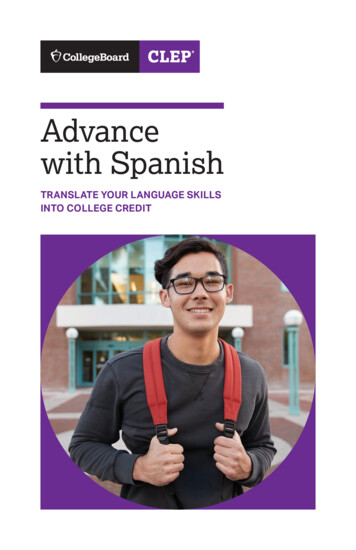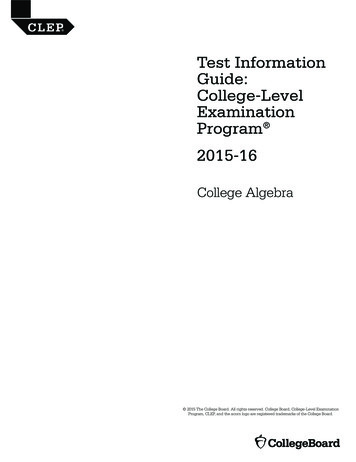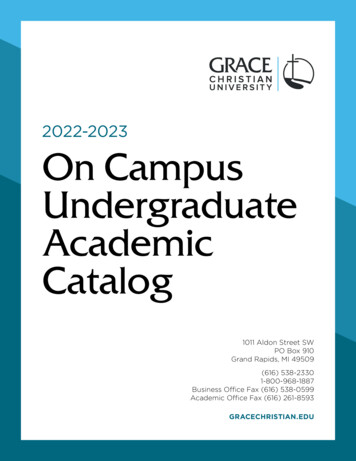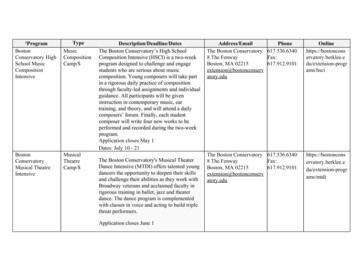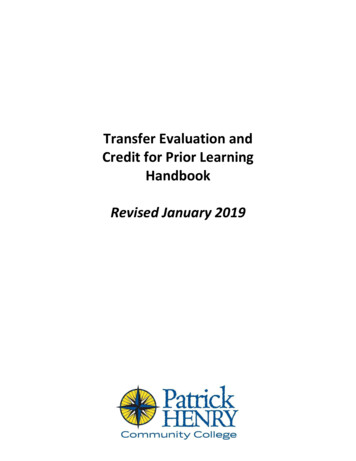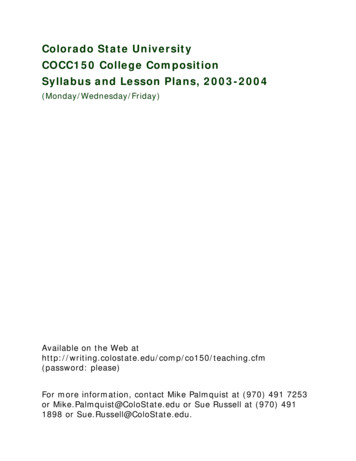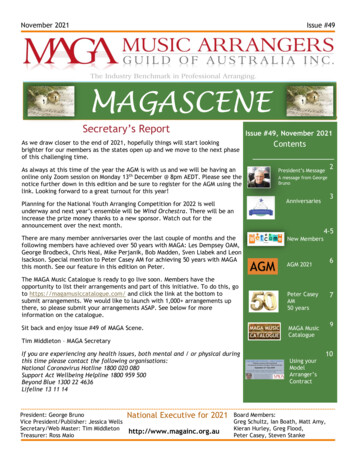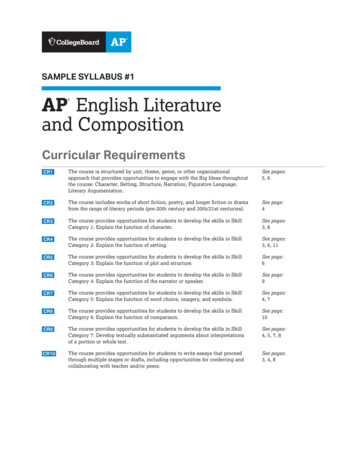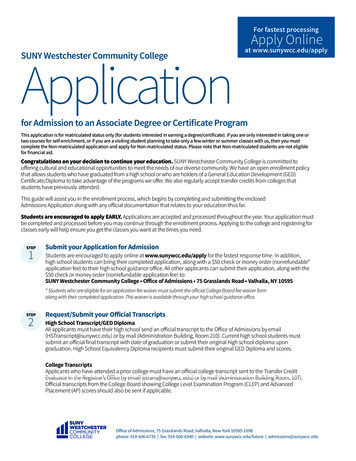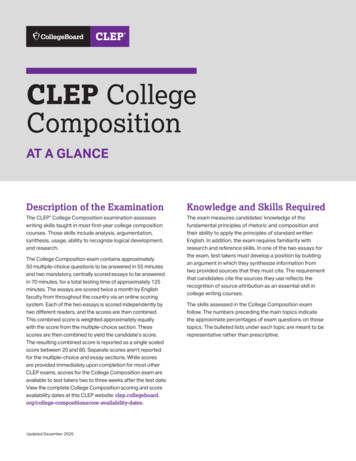
Transcription
CLEP CollegeCompositionAT A GLANCEDescription of the ExaminationCLEP TheCollege Composition examination assesseswriting skills taught in most first-year college compositioncourses. Those skills include analysis, argumentation,synthesis, usage, ability to recognize logical development,and research.The College Composition exam contains approximately50 multiple-choice questions to be answered in 55 minutesand two mandatory, centrally scored essays to be answeredin 70 minutes, for a total testing time of approximately 125minutes. The essays are scored twice a month by Englishfaculty from throughout the country via an online scoringsystem. Each of the two essays is scored independently bytwo different readers, and the scores are then combined.This combined score is weighted approximately equallywith the score from the multiple-choice section. Thesescores are then combined to yield the candidate’s score.The resulting combined score is reported as a single scaledscore between 20 and 80. Separate scores aren’t reportedfor the multiple-choice and essay sections. While scoresare provided immediately upon completion for most otherCLEP exams, scores for the College Composition exam areavailable to test takers two to three weeks after the test date.View the complete College Composition scoring and scoreavailability dates at this CLEP website: ilability-dates.Updated December 2020Knowledge and Skills RequiredThe exam measures candidates’ knowledge of thefundamental principles of rhetoric and composition andtheir ability to apply the principles of standard writtenEnglish. In addition, the exam requires familiarity withresearch and reference skills. In one of the two essays forthe exam, test takers must develop a position by buildingan argument in which they synthesize information fromtwo provided sources that they must cite. The requirementthat candidates cite the sources they use reflects therecognition of source attribution as an essential skill incollege writing courses.The skills assessed in the College Composition examfollow. The numbers preceding the main topics indicatethe approximate percentages of exam questions on thosetopics. The bulleted lists under each topic are meant to berepresentative rather than prescriptive.
10% CONVENTIONS OF STANDARDWRITTEN ENGLISHThis section measures candidates’ awareness of a varietyof logical, structural, and grammatical relationships withinsentences. The questions test recognition of acceptableusage relating to the items below:§ Syntax (parallelism, coordination, subordination)§ Sentence boundaries (comma splice, run-ons, sentencefragments)§ Recognition of correct sentences§ Concord/agreement (pronoun reference, case shift andnumber, subject-verb, verb tense)§ Diction§ Modifiers§ Idiom§ Active/passive voice§ Lack of subject in modifying word group§ Logical comparison§ Logical agreement§ Punctuation25% ABILITY TO USE SOURCE MATERIALSThis section measures candidates’ familiarity with elementsof the following basic reference and research skills, whichare tested primarily in sets but may also be tested throughstand-alone questions. In the passage-based sets, theelements listed under Revision Skills and Rhetorical Analysismay also be tested. In addition, this section will cover thefollowing skills:§ Use of reference materials§ Evaluation of sources§ Integration of resource material§ Documentation of sources (including, but not limited to,MLA, APA, and Chicago manuals of style)25% RHETORICAL ANALYSISThis section measures candidates’ ability to analyze writing.This skill is tested primarily in passage-based questionspertaining to critical thinking, style, purpose, audience,and situation:§ Appeals§ Tone§ Organization/structure40% REVISION SKILLS§ Rhetorical effectsThis section measures candidates’ revision skills in thecontext of works in progress (early drafts of essays):§ Use of language§ Organization§ Evaluation of evidence§ Awareness of audience, tone, and purpose§ Level of detail§ Coherence between sentences and paragraphs§ Sentence variety and structure§ Main idea, thesis statements, and topic sentences§ Rhetorical effect and emphasis§ Use of language§ Evaluation of author’s authority and appeal§ Evaluation of reasoning§ Consistency of point of view§ Transitions§ Sentence-level errors primarily relating to theconventions of standard written English2§ Evaluation of evidenceTHE ESSAYSIn addition to the multiple-choice section, the CollegeComposition exam includes a mandatory essay sectionthat tests skills of argumentation, analysis, and synthesis.This section consists of two essays, both measure acandidate’s ability to write clearly and effectively. The firstessay is based on the test taker’s reading, observation, orexperience, while the second essay requires test takersto synthesize and cite two sources that are provided.Candidates have 30 minutes to write the first essay and40 minutes to read the two sources and write the secondessay. The essays must be typed on a computer.
FIRST ESSAY: DIRECTIONS AND SCORINGGUIDELINES§ is adequately developed, using reasons, examples,or details to support ideasDirections: Write an essay in which you discuss theextent to which you agree or disagree with the statementprovided. Support your discussion with specific reasons andexamples from your reading, experience, or observations.§ is generally focused and organized§ demonstrates competence with language, usingadequate vocabulary and minimal sentence varietyScoring Guidelines: Readers will assign scores based onthe following scoring guide.§ demonstrates control of the standard conventionsof grammar, usage, and mechanics but may havesome errors6 - A 6 essay demonstrates a high degree ofcompetence and sustained control, although itmay have a few minor errors.3 - A 3 essay demonstrates limited competence.A typical essay in this category:§ Addresses all elements of the writing task effectivelyand insightfully§ develops ideas thoroughly, using well-chosen reasons,examples, or details for support§ is well focused and well organized§ demonstrates superior facility with language, usingeffective vocabulary and sentence variety§ demonstrates general mastery of the standardconventions of grammar, usage, and mechanicsbut may contain minor errors5 - A 5 essay demonstrates a generally highdegree of competence, although it will haveoccasional lapses in quality.A typical essay in this category:§ Addresses the writing task effectively§ is well developed, using appropriate reasons, examples,or details to support ideas§ is generally well focused and well organized§ demonstrates facility with language, using appropriatevocabulary and some sentence variety§ demonstrates strong control of the standardconventions of grammar, usage, and mechanics, thoughit may contain minor errors4 - A 4 essay demonstrates clear competence,with some errors and lapses in quality.A typical essay in this category:§ Addresses the writing task adequately3A typical essay in this category exhibits ONE OR MORE ofthe following weaknesses:§ Addresses only some parts of the writing task§ is unevenly developed and often provides assertionsbut few relevant reasons, examples, or details§ is poorly focused and/or poorly organized§ displays frequent problems in the use of language§ demonstrates inconsistent control of grammar, usage,and mechanics2 - A 2 essay is seriously flawed.A typical essay in this category exhibits ONE OR MORE ofthe following weaknesses:§ Is unclear or seriously limited in addressing thewriting task§ is seriously underdeveloped, providing few reasons,examples, or details§ is unfocused and/or disorganized§ displays frequent serious errors in the use of languagethat may interfere with meaning§ contains frequent serious errors in grammar, usage, andmechanics that may interfere with meaning1 - A 1 essay is fundamentally deficient.A typical essay in this category exhibits ONE OR MOREof the following weaknesses:§ Provides little or no evidence of the ability to develop anorganized response to the writing task§ is undeveloped§ contains severe writing errors that persistently interferewith meaning
0 - Off topic§ Provides no evidence of an attempt to respond tothe assigned topic, is written in a language other thanEnglish, merely copies the prompt, or consists of onlykeystroke characters.SECOND ESSAY: DIRECTIONS AND SCORINGGUIDELINESDirections: This assignment requires you to write acoherent essay in which you synthesize the two sourcesprovided. Synthesis refers to combining the sources andyour position to form a cohesive, supported argument. Youmust develop a position and incorporate both sources.You must cite the sources whether you’re paraphrasing orquoting. Refer to each source by the author’s last name, thetitle, or by any other means that adequately identifies it.Scoring Guidelines: Readers will assign scores based onthe following scoring guide.6 - A 6 essay demonstrates a high degree ofcompetence and sustained control, although itmay have a few minor errors.A typical essay in this category cites sourcesappropriately, and:§ Develops a position effectively and insightfully, usingwell-chosen reasons, examples, or details for support§ synthesizes* both sources effectively, with an effectiveand convincing link between the sources and the position§ is well focused and well organized§ demonstrates superior facility with language, usingeffective vocabulary and sentence variety§ demonstrates general mastery of the standardconventions of grammar, usage, and mechanics butmay have minor errors5 - A 5 essay demonstrates a generally highdegree of competence, although it will haveoccasional lapses in quality.A typical essay in this category cites sourcesappropriately, and:§ Develops a position consistently, using appropriatereasons, examples, or details for support§ synthesizes* both sources clearly, with a clear linkbetween the sources and the position§ is generally well focused and well organized§ demonstrates facility with language, using appropriatevocabulary and some sentence variety§ demonstrates strong control of the standardconventions of grammar, usage, and mechanics butmay have minor errors4 - A 4 essay demonstrates competence, withsome errors and lapses in quality.A typical essay in this category cites sourcesappropriately, and:§ Develops a position adequately, using reasons,examples, or details for support§ synthesizes* both sources adequately, with a linkbetween the sources and the position§ is adequately focused and organized§ demonstrates competence with language, usingadequate vocabulary and minimal sentence variety§ generally demonstrates control of the standardconventions of grammar, usage, and mechanics butmay have some errors3 - A 3 essay demonstrates limited competence.A typical essay in this category exhibits ONE OR MORE ofthe following weaknesses:§ Develops a position unevenly, often using assertionsrather than relevant reasons, examples, or details forsupport§ synthesizes* one source only, or two sourcesinadequately, or establishes an inadequate link betweenthe source(s) and the position§ displays problems in citing sources: citations areconfusing or incomplete§ is poorly focused and/or poorly organized§ displays frequent problems in the use of language§ demonstrates inconsistent control of grammar, usage,and mechanics2 - A 2 essay is seriously flawed.A typical essay in this category exhibits ONE OR MORE ofthe following weaknesses:* For the purposes of scoring, synthesis refers to combining the sources and the writer’s position to form a cohesive, supported argument.4
§ is seriously underdeveloped, providing few or norelevant reasons, examples, or details for support§ synthesizes* only one source weakly, or establishes avery weak link between the source(s) and the position§ does not cite any source§ is unfocused and/or disorganized§ displays frequent serious errors in the use of languagethat may interfere with meaning§ contains frequent serious errors in grammar, usage, andmechanics that may interfere with meaning1 - A 1 essay is fundamentally deficient.A typical essay in this category exhibits ONE OR MORE ofthe following weaknesses:§ does not develop a position§ fails to synthesize the source(s) used, or uses nosources at all§ contains severe writing errors that persistently interferewith meaning0 - Off topic§ Provides no evidence of an attempt to respond tothe assigned topic, is written in a language other thanEnglish, merely copies the prompt, or consists of onlykeystroke characters.* See note on preceding page.5Study ResourcesMost textbooks used in college-level composition coursescover the skills and topics measured in the CollegeComposition exam, but the approaches to certain topics andthe emphasis given to them may differ. To prepare for theCollege Composition exam, it’s advisable to study one or morecollege-level texts, such as readers, handbooks, and writingguides. When selecting a text, check the table of contentsagainst the knowledge and skills required for this test.To become aware of the processes and principles involvedin presenting your ideas logically and expressing themclearly and effectively, you should practice writing. Ideally,you should try writing about a variety of subjects and issues,starting with those you know best and care the most about.Ask someone you know and respect to respond to whatyou write and help you discover which parts of your writingcommunicate effectively and which parts need revisionto make the meaning clear. You should also try to read theworks of published writers in a wide range of subjects,paying particular attention to the ways in which the writersuse language to express their meaning.
Sample Test QuestionsQuestions 2–5 refer to the following passage:The following sample questions don’t appear on an actualCLEP exam. They’re intended to give potential test takersan indication of the format and difficulty level of the examand to provide content for practice and review. For moresample questions and information about the test, see theCLEP Official Study Guide.(1) In observing a live performance such as a play or astand-up routine, each individual member of the audienceis affected by the group’s emotional response to the show.(2) Some research shows that audience members are likelyto laugh along with the laughter of others in the audiencemuch more frequently than they would laugh at the sameperformance if viewing it alone.CONVENTIONS OF STANDARD WRITTENENGLISH (10%)(3) As performances moved to radio and television in thefirst half of the twentieth century, producers were well awareof the important role of this social laughter. (4) Early radioand television comedies were broadcast live with a realaudience in the studio to provide the reactions that helpedat-home audiences feel connected to the performance.(5) As advances in technology allowed performances tobe prerecorded, edited, and enhanced for later broadcast,recorded laughter gained wider use. (6) It can be called“canned laughter” or a “laugh track.”Directions: Read each sentence carefully, paying particularattention to the underlined portions. You’ll find that the error,if there’s one, is underlined. Assume that elements of thesentence that aren’t underlined are correct and can’t bechanged. In choosing answers, follow the requirements ofstandard written English.If there’s an error, select the one underlined part that mustbe changed to make the sentence correct.If there’s no error, select No error.1.Improbable as it may seem when one observesABits awkwardness on land, penguins are extremelyCDgraceful swimmers. No errorEREVISION SKILLS (40%)Directions: The following passage is an early draft of an essay.Read the passage and then answer the questions thatfollow. Some questions refer to particular sentences or partsof sentences and ask you to improve sentence structureor diction (word choice). Other questions refer to the entireessay or parts of the essay and ask you to consider theessay’s organization, development, or effectiveness oflanguage. In selecting your answers, follow the conventionsof standard written English.6(7) The laugh track gives producers the ability to createan audience response that aligns with the finished, editedperformance. (8) In live broadcasts, the show is performedfrom beginning to end without stopping, and live studioaudiences have an authentic, if unpredictable, response tothe performance, just like that of audiences listening orwatching at home. (9) In a recorded performance, though,directors are free to stop the scene, ask performers to redoa particular segment or have the crew switch equipment,and start again. (10) This interrupted, disjointed style ofperformance makes it difficult for them to hold a live studioaudience’s interest. (11) Therefore, editors often add recordedlaughter into the final edited version of the program.(12) Highlighting each joke with just the right volume,duration, and quality of laughter to prompt audiences athome to laugh at the intended times. (13) Although somecontemporary television comedies do not use a laughtrack, many programs for children and adults alike rely onrecorded laughter to create a sense of audience participation.2.Which of the following, if inserted immediately beforesentence 1, would make the best introduction to the passage?A. There are actually scientists who study human laughter.B. The laughter you hear on many television comedies wasprobably prerecorded.C. The technology used to produce radio and televisionprograms has advanced rapidly.D. Many people believe that comedy is less meaningfulthan drama, but both can evoke strong emotionalresponses.E. Shared laughter has a powerful influence on anaudience’s relationship to a performance.
3.In context, which of the following is the best revision tothe underlined portion of sentence 2 (reproduced below)?5.Some research shows that audience members are likely tolaugh along with the laughter of others in the audiencemuch more frequently than they would laugh at the sameperformance if viewing it alone.A.B.C.D.E.4.As advances in technology allowed performances to beprerecorded, edited, and enhanced for later broadcast,recorded laughter gained wider use. It can be called“canned laughter” or a “laugh track.”A. As advances in technology allowed performancesto be prerecorded, edited, and enhanced for laterbroadcast, recorded laughter gained wider use; itcan be called “canned laughter” or a “laugh track.”B. As advances in technology allowed performancesto be prerecorded, edited, and enhanced for laterbroadcast, recorded laughter—called “cannedlaughter” or a “laugh track”—gained wider use.C. As advances in technology allowed performancesto be prerecorded, edited, and enhanced for laterbroadcast, recorded laughter, they call it “cannedlaughter” or a “laugh track,” which then gainedwider use.D. As advances in technology allowed performancesto be prerecorded, edited, and enhanced for laterbroadcast, “canned laughter” or a “laugh track”gained wider use; this is recorded laughter.E. As advances in technology allowed performancesto be prerecorded, edited, and enhanced for laterbroadcast, recorded laughter having gained wideruse, called “canned laughter” or a “laugh track.”7Highlighting each joke with just the right volume, duration,and quality of laughter to prompt audiences at home tolaugh at the intended times.A. Insert a comma after “laughter” and change “toprompt” to “prompting.”B. Add “with the performance” at the end of thesentence.C. Add it to the end of sentence 11, using a commabefore the word “highlighting.”D. Delete it from the passage.E. Leave it as it is.However, someNonetheless, someIn contrast, someIn fact, someConversely, someWhich of the following is the best way to combinesentences 5 and 6 (reproduced below)?In context, which of the following is best to do withsentence 12 (reproduced below) ?ABILITY TO USE SOURCE MATERIALS (25%)Directions: The following questions test your familiarity withbasic research, reference, and composition skills. Somequestions refer to passages, while other questions are selfcontained. For each question, choose the best answer.Questions 6–7 [APA Style]Cramton, C. D., & Hinds, P. J. (2004). Subgroup dynamics ininternationally distributed teams: ethnocentrism or crossnational learning? Research in Organizational Behavior, 26,231–263. https://doi.org/10.1016/S0191-3085(04)26006-36.The citation shown refers toA. A chapter in a bookB. A conference paperC. A newspaper editorialD. An essay in an anthologyE. A journal article
Question 7 refers to the following passage:(1) In the typical movie theater in the United States, pricingis established by convention rather than by economicrationality: it costs as much to see an unpopular movie as itdoes to see a hugely popular one. (2) Although movie ticketprices varied somewhat in the early history of film (Bakker,2008), most Americans are not aware of this, so the modernpractice seems only natural. (3) But from an economicperspective, it makes little sense. (4) In any given week, somemovies will be playing to packed houses, while others will beplaying to vacant theaters. (5) As the economists Liran Einavand Barak Orbach (2001) have written, movie theaters “denythe law of supply and demand” (p. 29). (6) Normally, whendemand is high and supply is low, companies raise prices,and when the situation is reversed, they lower prices. (7)But American movie theaters charge the same price for allmovies regardless of popularity.ReferencesBakker, Gerben. “The Economic History of the InternationalFilm Industry.” EH.Net Encyclopedia. February 10, ory-of-theinternational-film-industry/.Orbach, Barak, and Einav, Liran. “Uniform Prices forDifferentiated Goods: The Case of the Movie-TheaterIndustry.” Harvard John M. Olin Discussion Paper Series,Harvard Law School, Cambridge, MA, paper 337, October2001. http://www.law.harvard.edu/programs/olin center/papers/pdf/337.pdf.7.8In sentence 5, the author cites Einav and Orbach mostlikely to:A. Indicate that convention often plays a role in theprices of goods and servicesB. Provide support for the assertion that movie ticketprices do not make sense economicallyC. Point out that some movies are extremely popular,while others are playing to empty housesD. Challenge the claim that movie ticket prices arebased on conventionE. Explain the advantages of using the same ticketprices for all moviesRHETORICAL ANALYSIS (25%)Directions: The following questions test your ability toanalyze writing. Some questions refer to passages, whileother questions are self-contained. For each question,choose the best answer.Questions 8–10 refer to the following passage:(1) There was a steaming mist in all the hollows, and it hadroamed in its forlornness up the hill, like an evil spirit, seekingrest and finding none.(2) A clammy and intensely cold mist, it made its slow waythrough the air in ripples that visibly followed and overspreadone another, as the waves of an unwholesome sea might do.(3) It was dense enough to shut out everything from the light ofthe coach-lamps but these its own workings, and a few yards ofroad; and the reek of the labouring horses steamed into it, as ifthey had made it all.(4) Two other passengers, besides the one, were plodding upthe hill by the side of the mail. All three were wrapped to thecheekbones and over the ears, and wore jack-boots. (5) Not oneof the three could have said, from anything he saw, what eitherof the other two was like; and each was hidden under almost asmany wrappers from the eyes of the mind, as from the eyes ofthe body, of his two companions.8.Which of the following pairs of literary devices appearsin sentence 1?A. Alliteration and onomatopoeiaB. Metaphor and juxtapositionC. Personification and simileD. Irony and paradoxE. Point of view and stream of consciousness9.Which of the following best summarizes the meaning ofsentence 5 (reproduced below)?Not one of the three could have said, from anything he saw,what either of the other two was like; and each was hiddenunder almost as many wrappers from the eyes of the mind,as from the eyes of the body, of his two companions.A. Even though the passengers were friends, none ofthem knew how the others were feeling.B. Two of the passengers were attempting to concealwhat they knew from the third passenger.C. The dense fog made it hard for the coachman to keeptrack of the passengers.D. None of the passengers could discern the appearanceor character of the other two passengers.E. All of the passengers had witnessed something theywere afraid of but could not discuss with each other.
10. The overall mood of the passage can best be described as:A. OminousB. MelancholyC. NostalgicD. DepressingE. SereneCredit RecommendationsThe American Council on Education has recommendedthat colleges grant six credits for a score of 50, which isequivalent to a course grade of C, on the CLEP CollegeComposition exam. Each college, however, is responsiblefor setting its own policy. For candidates with satisfactoryscores on the CLEP College Composition exam, collegesmay grant credit toward fulfillment of a distributionrequirement, or for a particular course that matches theexam in content. Check with your school to find out thescore it requires for granting credit, the number of credithours granted, and the course that can be bypassed with apassing score.Answers to Sample Questions:1-C; 2-E; 3-D; 4-B; 5-C; 6-E; 7-B; 8-C; 9-D; 10-A9 2021 College Board. College Board, CLEP, and the acorn logo are registered trademarks of College Board.All other marks are the property of their respective owners. Visit College Board on the web: collegeboard.org.01729-104
The CLEP College Composition examination assesses writing skills taught in most first-year college composition courses. Those skills include analysis, argumentation, synthesis, usage, ability to recognize logical development, and research. The College Composition exam contains approximately 50 multiple-choice questions to be answered in 55 .
